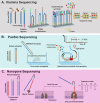Current challenges and best-practice protocols for microbiome analysis
- PMID: 31848574
- PMCID: PMC7820839
- DOI: 10.1093/bib/bbz155
Current challenges and best-practice protocols for microbiome analysis
Abstract
Analyzing the microbiome of diverse species and environments using next-generation sequencing techniques has significantly enhanced our understanding on metabolic, physiological and ecological roles of environmental microorganisms. However, the analysis of the microbiome is affected by experimental conditions (e.g. sequencing errors and genomic repeats) and computationally intensive and cumbersome downstream analysis (e.g. quality control, assembly, binning and statistical analyses). Moreover, the introduction of new sequencing technologies and protocols led to a flood of new methodologies, which also have an immediate effect on the results of the analyses. The aim of this work is to review the most important workflows for 16S rRNA sequencing and shotgun and long-read metagenomics, as well as to provide best-practice protocols on experimental design, sample processing, sequencing, assembly, binning, annotation and visualization. To simplify and standardize the computational analysis, we provide a set of best-practice workflows for 16S rRNA and metagenomic sequencing data (available at https://github.com/grimmlab/MicrobiomeBestPracticeReview).
Keywords: 16S rRNA sequencing; amplicon sequencing; assembly; functional and taxonomic classification; metagenomics; microbiome.
© The Author(s) 2019. Published by Oxford University Press.
Figures




References
-
- Kamada N, Seo SU, Chen GY, et al. Role of the gut microbiota in immunity and inflammatory disease. Nat Rev Immunol 2013;13:321–35. - PubMed
-
- Philippot L, Raaijmakers JM, Lemanceau P, et al. Going back to the roots: the microbial ecology of the rhizosphere. Nat Rev Microbiol 2013;11:789–99. - PubMed
-
- Zilber-Rosenberg I, Rosenberg E. Role of microorganisms in the evolution of animals and plants: the hologenome theory of evolution. FEMS Microbiol Rev 2008;32:723–35. - PubMed
Publication types
MeSH terms
Substances
LinkOut - more resources
Full Text Sources
Other Literature Sources

